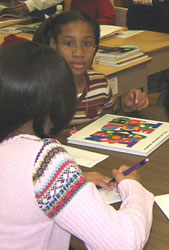Evidence
Although young people aren't expected to be lawyers, they should be able to identify, organize, and cite evidence. Evidence is information that can be used to demonstrate the truth of an assertion. Student investigators can test information and seek verification, second opinions, and validation of content by checking credentials, publishers and impressions from his peers (fellow students) and mentors (instructional media specialists).
 Barbara Stripling has written one of the most comprehensive and convincing essays on the relationships among inquiry-based learning, information literacy and k-12 curriculum. Among a rich list of curricular ties, she offers these examples that illustrate how teaching inquiry involves applications at different grade levels with the instructional media specialists working collaboratively to facilitate a progressive scaffolding of investigative experiences from elementary to secondary school (2003, page 26).
Barbara Stripling has written one of the most comprehensive and convincing essays on the relationships among inquiry-based learning, information literacy and k-12 curriculum. Among a rich list of curricular ties, she offers these examples that illustrate how teaching inquiry involves applications at different grade levels with the instructional media specialists working collaboratively to facilitate a progressive scaffolding of investigative experiences from elementary to secondary school (2003, page 26).
"Evaluation of sources is critical to inquiry in social studies because of the interpretative nature of the discipline. Students should assess the value of a source before they even look at the specific information within the source. If teachers and librarians have selected the source, then they should share their thinking process with students. The criteria that need to be emphasized (at age-appropriate times) are authoritativeness of the author/publisher; comprehensiveness of the information (students are seeking in-depth information, not collections of superficial facts); organization and clarity of the text (students need to be able to find and comprehend relevant information without getting lost in extraneous links or subtopics); and quality of the references (the sources of the cited evidence) [and further understand our quality citations can lead to additional relevant evidence]. Obviously, in the age of the Internet, responsibility for evaluation of sources has largely shifted from librarians to students. Careful instruction and guidance must accompany that shift.
Evaluation of specific information and evidence is also a key thinking strategy for inquiry in social studies. Librarians and classroom teachers probably want to emphasize discernment of fact versus opinion and help students understand how each can be used effectively. Students, particularly as the secondary level, must learn how to identify point of view and recognize its effect on the evidence. Their responsibility is to find enough evidence from different points of view that they [may consider] … a balanced perspective. Sources that present opposing viewpoints are helpful to provide that [attempted] balance of evidence. Secondary students must also be taught to detect degrees of bias (from slightly slanted point of view to heavily slanted propaganda)."
![]() Read Key Word: Evidence in THE BLUE BOOK by Callison and Preddy, 369-377.
Read Key Word: Evidence in THE BLUE BOOK by Callison and Preddy, 369-377.
